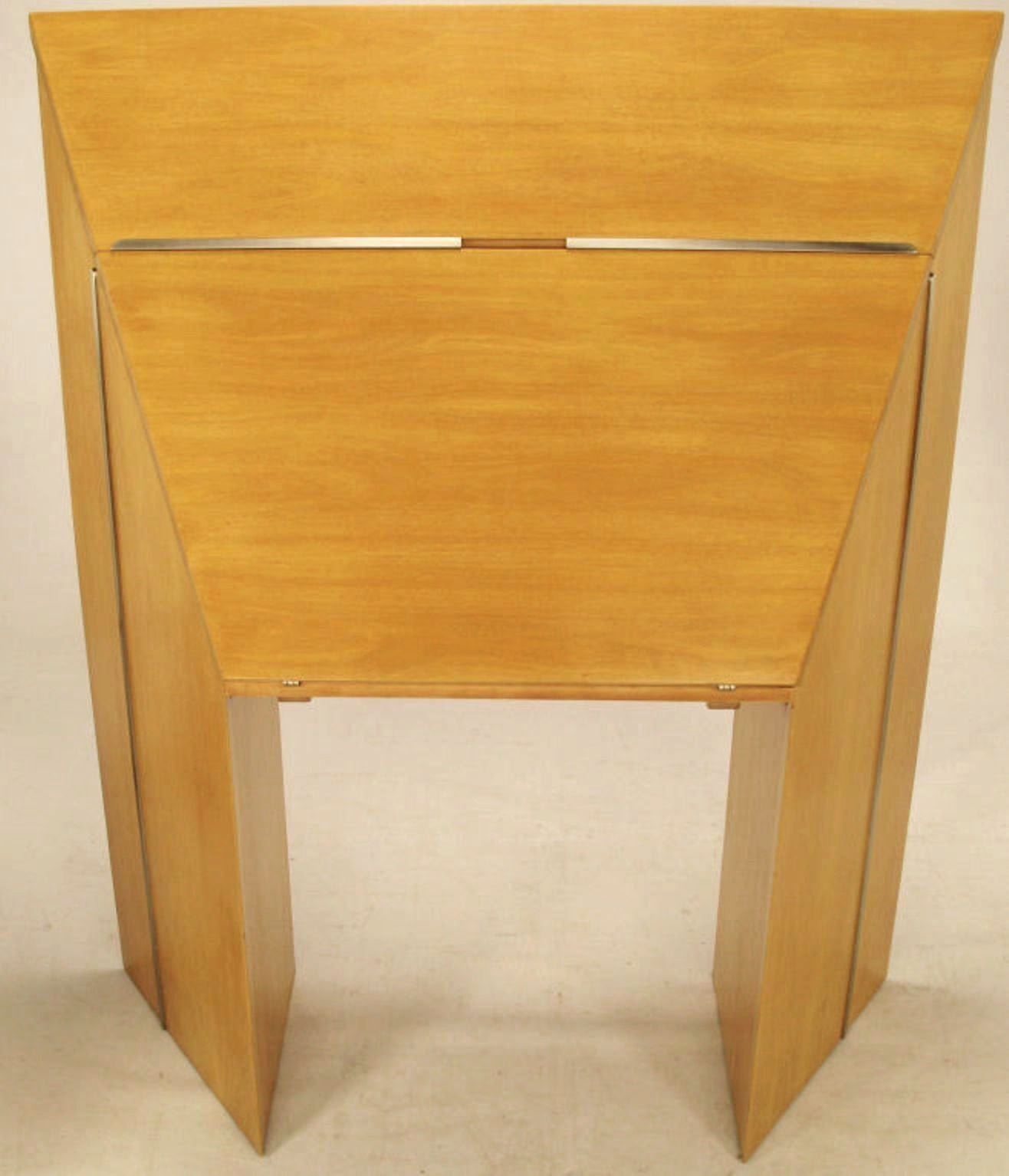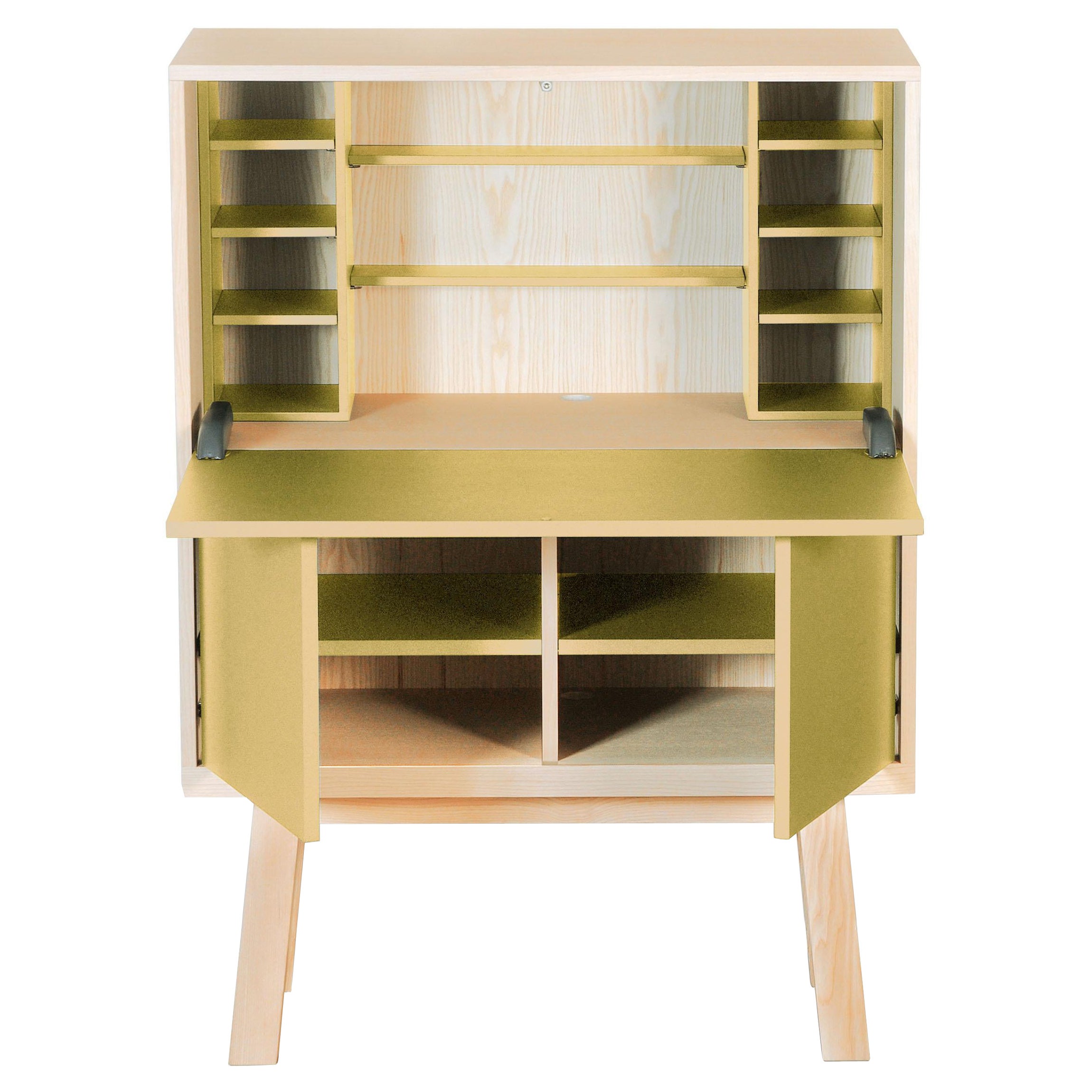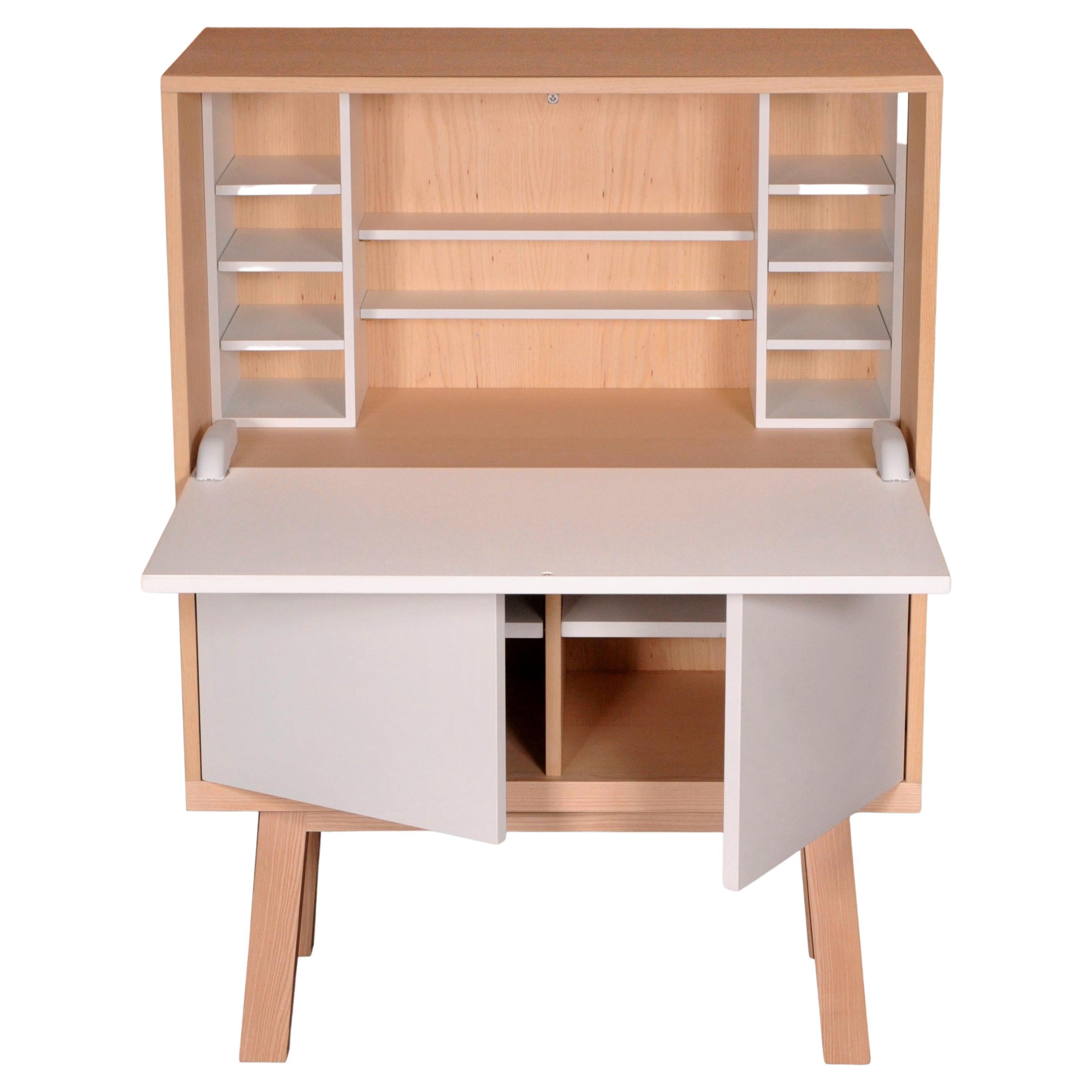Items Similar to Frank Brangwyn a Rare Desk Originally Designed for the 1931 Pollard Exhibition
Want more images or videos?
Request additional images or videos from the seller
1 of 11
Frank Brangwyn a Rare Desk Originally Designed for the 1931 Pollard Exhibition
About the Item
Frank Brangwyn. E Pollard and Co.
A rare desk originally designed for the 1931 Pollard Exhibition where it can be seen in a room setting in the original photographs from 1931. See images.
This desk was on display at the Scarborough Museums Trust's exhibition 'Brangwyn 1867-1956: Man of the People', in 2016. Co-curated by Dr Libby Horner, she focuses on prominent themes within the collection of 'the lives of man, at work, at rest and in times of distress'.
Born in Bruges and raised in London, Brangwyn grew up in a bubble of creativity. His father was a renowned Architect, winner of a silver medal in the Paris Exhibition, and his two siblings thrived in the field of Interior Design out in the US.
Brangwyn is not the result of an extensive Arts education but in fact a young man whom in the early stages of his artist life was exposed to three immensely inspiring and engaging designers of the time- A H Mackmurdo, William Morris, and Siegfried Bing. Their discovery of Brangwyn back in 1882, lead to collaborative and group work at the Century Guild, where shortly after he was taken under the wing of Morris to practice in his workshops at Queen Square on Flemish tapestries.
It didn’t go unnoticed that there were two fundamental themes that echoed throughout this experiential learning; the value of drawing from nature, and hence the value of a work ethic.
A notable stepping stone in Brangwyn’s professional practice and platform to the public, was the mural he was commissioned to execute at the age of 28 in 1895 at Galeries L’Art Nouveau in Paris, owned by supporter and mentor Bing. From this, a confident designer flourished. His designs broadened and began materialising in a range of mediums, from textiles through to glass and jewellery, to furniture for floors and decorative pieces for walls.
Only a year later, Brangwyn married a lady named Lucy Ray, whom was to be his partner managing Temple Lodge, a Georgian house in Hammersmith, and later The Jointure House in Ditchling.
During his travels through English fishing villages and communities, up until 1913, he was able to mature his collection of drawing material by experiencing the world in pieces; France, Italy, Morocco and an array more.
By the end of Brangwyn’s life, his extensive collection consisted of more than 20 mural commissions, 685 paintings, of which a further 265 are not dated, not forgetting etchings, lithographs, and wood engravings, exceeding 1,000.
- Creator:Frank Brangwyn (Designer),E. Pollard & Co (Cabinetmaker)
- Dimensions:Height: 32 in (81.28 cm)Width: 48 in (121.92 cm)Depth: 28 in (71.12 cm)
- Style:Art Deco (Of the Period)
- Materials and Techniques:
- Place of Origin:
- Period:
- Date of Manufacture:1931
- Condition:
- Seller Location:London, GB
- Reference Number:1stDibs: LU2243312593821
About the Seller
5.0
Vetted Seller
These experienced sellers undergo a comprehensive evaluation by our team of in-house experts.
Established in 1989
1stDibs seller since 2016
236 sales on 1stDibs
Typical response time: <1 hour
- ShippingRetrieving quote...Ships From: London, United Kingdom
- Return PolicyA return for this item may be initiated within 3 days of delivery.
More From This SellerView All
- Frank Brangwyn, Armchair for the Canadian Pacific Liner 'SS Empress of Britain'By Frank BrangwynLocated in London, GBFrank Brangwyn. An important armchair. Brangwyn's last interior designs were for the Canadian Pacific Liner; 'The SS Empress of Britain', which was launched in 1931 by the Prince of Wales, later to be King Edward VIII who renounced his throne to marry Wallis Simpson in 1930. These armchairs were designed for the 1st class dining room; 'The Salle Jacque Cartier' (see last image) and they were made by H.H. Martyn and Co. Cheltenham. The 1st class dining room was described in the Bulletin of The Decorative Arts Society 1890-1940 as 'In the fully fledge modern restaurant and cinema style of the 1930s'. The Studio in a long article on the liner, discusses and illustrates Brangwyn's Salle Jacques Cartier: 'So architectural it is, so true proportion, so devoid of Extraneous ornament. In contrast to this austerity of line, hue and colour, his great wall paintings are rich in colour; composed in the bold, yet intricate pattern of figure, fruit and flowers that characterizes Mr Brangwyn's decorative works'. Tragically the liner was sunk in 1940 by a U-boat. Brangwyn also designed marquetry panels for the private dining rooms and they were executed by the Rowley Gallery, he also designed a frieze carved in wood for their gallery façade in 1936. The armchair has a central under bar below the seat which still has the original bolt and eye to secure the chain to and then to the floor, that would prevent all the chairs from sliding around in stormy weather. It is lacking ivorene numbered disc which would have sat in the very top of the head rail. In October 1940 the most famous of the Canadian Pacific Railway liners and flagship of the company's Atlantic Fleet, the Empress of Britain, was attacked and sunk. She was travelling to Glasgow from Suez via South Africa, where she was bombed near the north-west coast of Ireland by a German Focke Wulf Condor plane. When the Condor attacked the Empress of Britain the ship's crew couldn't shoot the plane down and soon the Empress was burning out of control and the Captain C.H. Sapsworth gave the order to abandon ship. 45 people died and the remaining survivors including women and children, were later rescued that day by the British destroyer HMS Echo and the Polish destroyer Burza and 3 British naval trawlers Paynter, Cape Agona and Drangey. The Empress still burning managed to stay afloat and the day after 2 Royal Navy tugs, Marauder and Thames tried to tow her into port with many escort ships around her but in spite of the protection she was given from the escort ships on October 28th, a German U-boat, U-32, managed to get by the escorts un-noticed and torpedoed the crippled Empress. She sank within ten minutes. The Empress of Britain was the largest Allied passenger liner to be sunk and weighing 42,348-tons she was the biggest merchant ship loss of the war. King George VI and Queen Elizabeth had travelled aboard Empress of Britain after their 1939 Royal Tour...Category
Vintage 1930s English Arts and Crafts Armchairs
MaterialsOak
- Collinson & Lock, Attri to E W Godwin, A Fine Quality Rosewood Writing TableBy Collinson & Lock, Edward William GodwinLocated in London, GBCollinson and Lock. Attributed to E W Godwin. An exceptional quality rosewood writing table with five upper drawers and stylized swan neck drop handles with eight finely turned legs each set of four united by circular pierced details. Renewed period style leather work area. Collinson and Lock of London 'Art Furnishers', founded with the partnership of F.G. Collinson and G.J. Lock, former employees of Jackson and Graham. Designers employed by the firm included T.E. Collcutt, the architect of their premises; E.W. Godwin, who was paid a retainer to produce exclusive designs for the company from 1872 to 1874, H.W. Batley and Stephen Webb...Category
Antique 1870s English Anglo-Japanese Desks and Writing Tables
MaterialsRosewood
- Rare Walnut Desk in the Anglo-Japanese Style Designed by Thomas JeckyllBy Thomas Jeckyll, Charles Hindley & SonsLocated in London, GBA fine and rare walnut desk in the Anglo-Japanese style designed by Thomas Jeckyll and made by Charles Hindley and Sons. “Thomas Jeckyll designed some of the earliest surviving furniture inspired in decoration if not in form- by interest in Japan” (Cooper p. 138). As can be seen on the desk, the style and design details such as the ‘Key’ design, the Japanese style lacquered door panels, the cross hatching and circle design on the brass door brackets, all combine to create a unique example of Jeckyll’s Anglo-Japanese work. The ‘Key’ design on the desk appears on many of Jeckyll’s designs including the cast iron grates and fenders made by Barnard, Bishop and Barnards and on furniture designed for ‘Alecco’ Ionides for his home at no1 Holland Park, London in circa 1875. The ‘Peacock’ dining...Category
Antique Late 19th Century Anglo-Japanese Desks and Writing Tables
MaterialsWalnut
- Sir Frank Brangwyn attr. Pair of Arts & Crafts mahogany armchairs Chinese styleBy Frank BrangwynLocated in London, GBSir Frank Brangwyn (attributed,) a pair of mahogany armchairs, in the Chinese style with professionally re-upholstered leather padded back and drop-in seat. These chairs share stylistic qualities with the famous armchairs he designed for the Salle Jacques Cartier aboard the SS Empress of Britain...Category
Early 20th Century British Arts and Crafts Armchairs
MaterialsMahogany
- Liberty & Co A Moorish Walnut Desk with Angular Design & 4 Opposite Side DrawersBy Liberty & Co.Located in London, GBLiberty & Co. A Moorish Walnut Desk with Mushrabia turnings to the upper shelf, just below to the turned uprights there are dowel holes which I have shown in the images, they are the...Category
Antique 1890s English Moorish Desks
MaterialsWalnut
- Shapland & Petter, Arts & Crafts Mahogany Desk with a Pierced Heart to the TopBy Shapland & PetterLocated in London, GBShapland & Petter. A wonderful Arts & Crafts mahogany writing desk with a pierced heart to the top, shaped back and sides, with upper three quarter shelf and a stylized floral leaded glass back below. A period style leather writing area with hand tooled gilt decoration to the edges. A bow fronted drawer with stylized copper heart...Category
Antique Early 1900s English Arts and Crafts Desks
MaterialsLeather, Mahogany
You May Also Like
- Rare Jay Spectre "Perceptive" Drop Front DeskBy Jay SpectreLocated in Chicago, ILPrimavera and brushed stainless steel drop front secretary has four drawers with brushed steel Art Deco inspired pulls, plus additional shelf storage. Origami angularity turns this e...Category
Late 20th Century American Desks and Writing Tables
MaterialsSteel
- Large Secretary Desk in Ash Design Eric Gizard, ParisBy Éric GizardLocated in Landivy, FRThis large secretary desk is designed by the famous parisian Designer Eric Gizard and delivered fully mounted. The overall dimensions of the b...Category
21st Century and Contemporary French Scandinavian Modern Desks and Writi...
MaterialsWood, Ash, Lacquer
- Light Yellow Secrétaire Desk, Design by E. Gizard, Paris, 11 ColoursBy Éric GizardLocated in Landivy, FRThis secretary Desk belongs to our ÉGÉE COLLECTION designed by the Parisian designer Eric Gizard. Eric adopts for this collection the refined codes of Scandinavian design, combin...Category
21st Century and Contemporary French Scandinavian Modern Secretaires
MaterialsWood, Ash, Lacquer
- blue French secrétaire desk with storage room, design by E. Gizard, ParisBy Éric GizardLocated in Landivy, FRThis secretary Desk belongs to our ÉGÉE COLLECTION and has been created in a KUBE concept for optimized storage spaces. The ÉGÉE collection is designed by the Parisian designer Eri...Category
21st Century and Contemporary French Scandinavian Modern Secretaires
MaterialsWood, Ash, Lacquer
- white secretary desk, PEFC certified ash wood, design by Eric Gizard ParisBy Éric GizardLocated in Landivy, FRThis Secretary desk in solid and veneer ash wood is designed by famous parisian Designer Eric Gizard The Kube itself (without the feet height) is Width 90 cm / 35.4'' x Height 90 cm / 35.4'' x Depth 46 cm / 18;11'' Measures: Height of the feet is 35 cm / 13.8'' Useful Height behind the lower hinged doors is 37 cm / 14.6'' Overall width of each compartment behind the hinged doors is 42 cm / 16.5'' and useful width is 38 cm / 15.0'' due to the hinges. The vertical interior divider can be moved during the manufacture process to allow the installation of printers with a width> 42 cm / 16.5''. The upper working part is fitted with a flap door on a "push-loose" opening for an efficient work with your laptop and smartphone. The storage space inside the cube and behind the flap is for your screen or to store your paperwork in the removable shelves. The 2 horizontal shelves and the 2 vertical storage...Category
2010s French Scandinavian Modern Secretaires
MaterialsAsh
- Dark blue secretary desk in wood, scandinavian design by Eric Gizard, ParisBy Éric GizardLocated in Landivy, FRÉGÉE collection This secretary desk is part of the ÉGÉE collection designed by Eric Gizard in Paris. Eric combines the sleek and refined codes of Scandinavian design with natural materials and muted and "trendy" colorful lacquers. This collection is made of French solid and veneer ash wood. This ÉGÉE desk is ideal for an efficient home or remote work with your laptop and smartphone. The storage space behind the flap is for your screen and you can easily store your paperwork in the removable shelves. The 2 horizontal shelves and the 2 vertical storage...Category
21st Century and Contemporary French Scandinavian Modern Desks and Writi...
MaterialsWood, Lacquer, Ash





